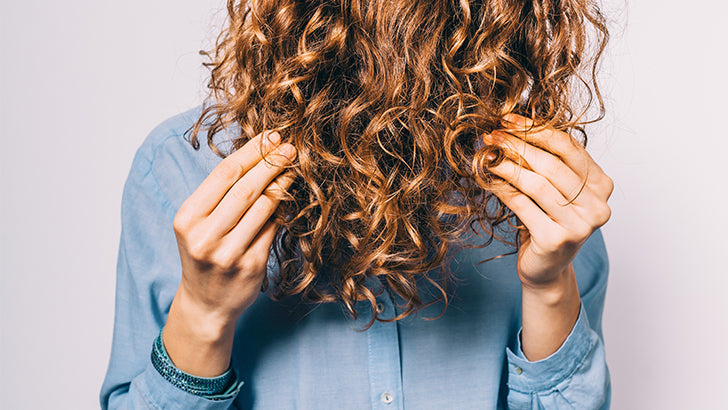
Using hair oils on curly hair provides many benefits, such as preventing breakage, locking in moisture and softening the hair. Oils can also enhance shine for more vibrant curls. There are several ways to use this essential product in your routine, and our guide shows you just how to use hair oil.
Table of Contents:
- 4 Ways to Use Hair Oils in Your Routine
- How to Identify the Best Oil for Your Hair Type
- Applying Oils: Wet or Dry?
4 Ways to Use Hair Oils in Your Routine
Learn how to use hair oils and discover how to enhance your curls and get the most out of your gorgeous locks. Curly hair oils can be used in different ways depending on what you want from your tresses.
The four ways to use the best curly hair oils, to help you see the benefits of hair oils, are:
- As a pre-poo treatment
- During your styling routine
- As the finishing touch
- As a night oil for hair growth
1. How to Use Hair Oil as a Pre-Shampoo
Using oils as a pre-shampoo treatment or “pre-poo” treatment helps reduce moisture loss and prevent breakage when shampooing. This is a particularly beneficial way to use hair oils for those with dry or high porosity hair that tends to lose moisture very quickly.
The oil coats the hair’s cuticle, filling in the gaps and preventing further damage. Rich oils or butters, like Curlsmith Intense Treatment Serum, are great when used as pre-poo treatments. Since you will wash them out afterwards, you don’t need to worry about them being heavy or creating build-up on the scalp, and you can reap the benefits of using hair oil even if you have a finer hair type.
- Divide dry hair into sections.
- Apply a small amount of oil to your palms and smooth over the hair. Avoid saturating the hair.
- Gently separate knots and detangle with your fingers.
- Use a brush to gently detangle if needed.
- Continue working one section at a time.
- Let the hair oil sit for at least 5 minutes to soak in.
- Shampoo, condition, and style as usual.
2. How to Use Hair Oils to Style Curls
It’s important to understand that oils are not hydrating hair products, so they can help to seal and lock in moisture, but they cannot fix dry hair. You need to use water and leave-in conditioners or curl creams to moisturise the hair before you use hair oil. These help to provide moisture and create clumps of curls to form.

There are different ways to use hair oils in order to aid your styling routine. The LOC method layers liquid, oil and then cream, while the LCO method layers liquid, cream and finally oil. The goal of these methods is to trap moisture in so your curls do not dry out in between washes.
LOC Method
The LOC method is great particularly for medium porosity or high porosity hair. Adding an oil right after the liquid step will help retain moisture, which is something these hair types struggle with.
- Start with clean, wet hair.
- Apply a leave-in conditioner.
- Smooth in a small amount of penetrating oil.
- Apply a curl cream and style as desired.
- Diffuse or air dry.
LCO Method
The LCO method may be a better option for low porosity hair. Adding the hair oil at the end will allow the cream to penetrate better, reducing the risk of weighing down the hair.
- Start with clean, wet hair.
- Apply a leave-in conditioner.
- Apply a curl cream and style as desired.
- Smooth in a small amount of sealing oil.
- Diffuse your hair or let it air dry.
Coarse hair textures or very dry hair benefits most from both methods. Many people with coily hair or type 4 hair also find these methods incredibly beneficial.
3. How to Finish your Style Using Hair Oils
Using hair oil in the last step of your styling routine will help with moisture retention by sealing the hair’s cuticle and promoting glossy hair. Sealing oils can slow the loss of moisture from your hair throughout the week in between washes.

Finishing your style with an oil can also help break up the crunchy gel cast resulting in soft, fluffy curls with shine. In this occasion, using a lightweight oil like Curlsmith Bonding Oil is ideal, as it will boost your hair shine without weighing it down.
- After styling your hair, wait until it’s 100% dry.
- Apply a small amount of oil to your palms and rub together.
- Smooth over the hair. Use the praying hands method if desired.
- Gently scrunch ends.
- Shake out the roots if desired for volume.
4. How to Use Oil at Night for Hair Growth
Massaging your scalp at night using hair oil has been known to help stimulate your hair follicles and promote hair growth. Many people may add it to their nighttime routine as a scalp treatment:
- Apply a small amount of oil to your fingertips and rub them together. Do not use too much!
- Massage the scalp from underneath the hair.
- Flip the hair upside down and massage the scalp to boost your hair volume and to increase blood flow.
- Repeat nightly.

However, newer research is starting to question the practice of oiling your scalp. Oils feed the bacteria that lives on the skin’s surface, so it could lead to a series of conditions including itchy scalp and flaky scalp.
How to Identify the Best Oil for Your Hair Type
You need to choose the best hair oils for your hair type, to see the benefits for your naturally curly hair. Oils are multi-purpose, so you can use hair oils at different times in your routine depending on which results you are after.
All hair types can benefit from their use, but you may want to choose a different type of oil depending on your specific needs. If you’re still unsure of what’s best for you, check out this regime builder quiz!
Applying Oils: Wet or Dry?
Hair oils can be applied to wet or dry curls, depending on the method which you are using the oil for.
- Applying hair oil on wet curls will help to seal in moisture as your locks dry.
- Applying hair oil to dry hair will add shine, smooth cuticles, and help to scrunch out any gel cast left from your styler.
For the methods outlined in this guide, use hair oils on wet hair as part of the LOC or LCO methods. Whereas, it is recommended to use hair oils on dry hair for the pre-shampoo method, to protect it overnight, and to finish your style.
Curly Hair Care for Every Hair Type
At Curlsmith, we create vegan hair products that are cruelty-free, and never contain parabens, silicones, and sulphates. Using only curl-friendly ingredients, our formulas help support your hair goals, transforming your tresses into locks you love.